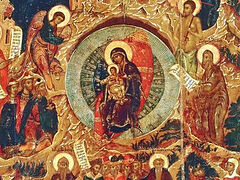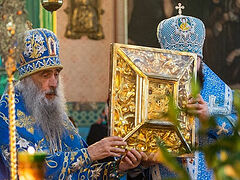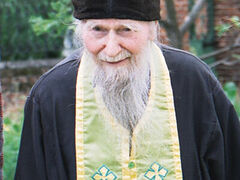In the ancient village of Stromyn1 near Moscow the author recorded the amazing story of the salvation of the miraculous Cypriot “Stromyn” Icon of the Mother of God.
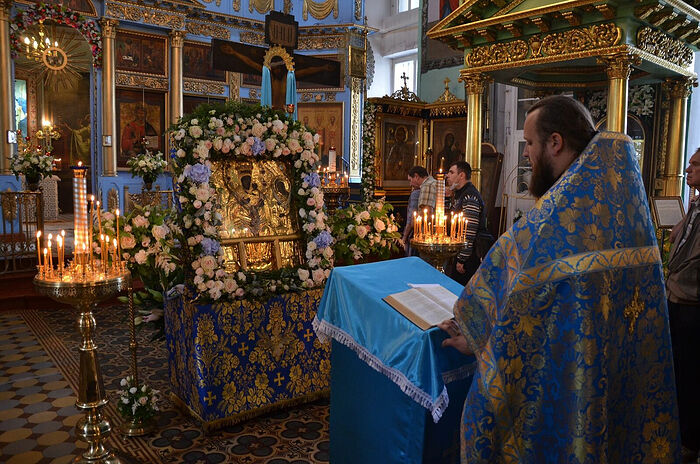 Miraculous Cypriot “Stromyn” Icon of the Mother of God
Miraculous Cypriot “Stromyn” Icon of the Mother of God
The healing of Maura Fayova
“Oh, everyone will ask about miracles again,” Photina Viktorovna Kulikova shakes her head. (The rector, Fr. Peter Torik, blessed Photina and her sister Lyubov Viktorovna Vakina to tell us this incredible story, with which the history of their family is intertwined). “And what is the main miracle? That a handful of people preserved an icon of the Mother of God, and She preserved our church. And this was at a time when people lost their lives for any wrong move...”
Our land is full of miracles, which are obvious or hidden until the right time. We for whom the Gospel explains things from a perspective that is different from what is generally accepted and worldly, where a widow’s two mites turn out to be more important than the millions of a rich man, and treasures collected in Heaven by mercy and prayer overshadow the most luxurious mansions built on earth, are called to look at the world with the eyes of the heart. This is probably how the angels look at Stromyn—a seemingly ordinary, modest and quite unfamous Russian village—and see a spiritual meadow of inexplicable beauty and grandeur, before which many capital cities fade. Here, under the protection of the Theotokos, lived Venerable Savva, confessor of the Holy Trinity-St. Sergius Lavra, the humble nineteenth-century ascetic Maura Fayova, and the strong-willed myrrh-bearing women of twentieth-century Stromyn, who were not afraid of the godless authorities...
In February 1841, St. Philaret (Drozdov) of Moscow was informed of the miraculous healing of an eighteen-year-old paralyzed girl from the village of Stromyn by a previously unknown icon of the Mother of God.2
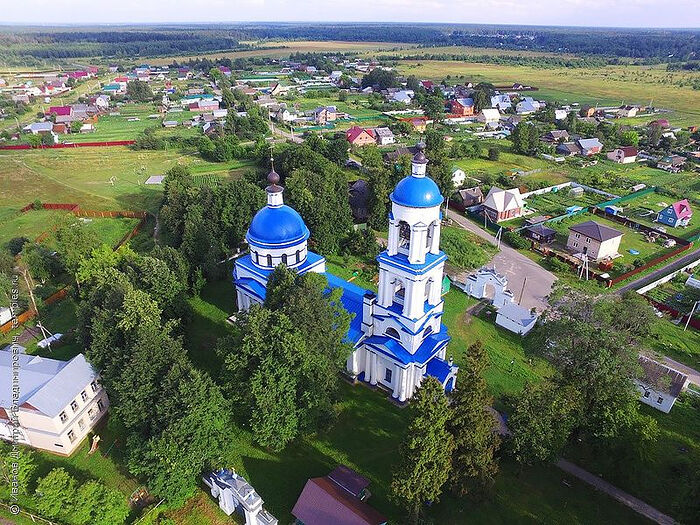 Holy Dormition Church in the village of Stromyn
Holy Dormition Church in the village of Stromyn
“The girl’s name was Maura (Mavra),” Photina Viktorovna continues. “Maura Ioakimovna Fayova, aged eighteen. Her mother had died, and she lived with her father, Ioakim Alexeyevich Fayov, and her stepmother. The family was well-off, but good and pious. The girl was seriously ill—she was paralyzed and couldn’t walk. One day the Mother of God appeared to her in a dream and said: ‘Find My icon in the church, bring it home, hold a service of intercession with a Blessing of Waters—and you will be healed.’ Maura told her father about the vision, but he (a pious and humble man) doubted: ‘Who are we that the Most Holy Theotokos Herself should come to us?’ The Mother of God appeared to Maura for the second time: ‘Find Me in the church.” And again Ioakim Alexeyevich did not believe his daughter. But he shared this with the church rector, Fr. Porfiry. Together, out of humility, they decided that it was just the result of the young lady’s fever. The Theotokos came to her for the third time in a dream and said that if her father did not believe this time, She would punish him. Frightened, he took a cart and brought Maura to church. They carried her in their arms around the church—from icon to icon. Maura looked at all of them but it turned out that the icon she’d seen in her dream was not there. There was nothing to be done! They took Maura out of the church. Once they had gone outside, she screamed, pointing upwards, ‘Here it is, here it is!’ They looked up and saw an old icon above the gate.”
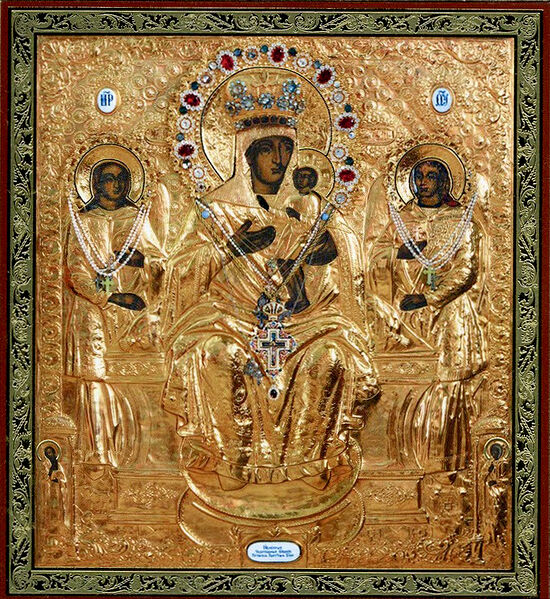 The wonderworking Cypriot “Stromyn” Icon of the Mother of God
The wonderworking Cypriot “Stromyn” Icon of the Mother of God
According to Christian tradition in Russia, over-the-gate icons were installed above monastery and church gates and fortress towers, blessing travelers who were setting off on their journeys.
The rector of the Holy Dormition Church, Fr. Porfiry (Flerov), took the icon down, brought it into the Fayovs’ house and celebrated a service of intercession with the Blessing of Waters.
“After that, right there,” as is written in “The Case of the Icon of the Mother of God of Cyprus from the Church of the Village of Stromyn, Bogorodsk District, Where Pilgrims Flock in Large Numbers” compiled for St. Philaret, “Maura felt a lightness and asked permission to bring the icon to the door of the house; then, feeling that her strength was increasing and finally her health restored completely, she brought [the icon] to the church and has been in perfect health ever since.”
The healing of the paralyzed girl shocked the entire neighborhood:
“After the service of intercession the icon was taken inside the church and placed on a table behind the left kliros; on the evening of the same day, at the request of peasants, the Vigil service was celebrated before this icon in the church. The next day, at the persistent request of those who came, a service of intercession began to be sung in front of the aforementioned icon. On the same and the following days, at the urgent request of peasants of the village of Stromyn, many of whom were then afflicted by fever, services of intercession were performed in all their houses in front of it. Upon receiving permission from His Beatitude to perform services of intercession before this icon, they were held in the villages of Botovo and Shchekavtsevo.”
From Lazarus the Four Days Dead to St. Sergius
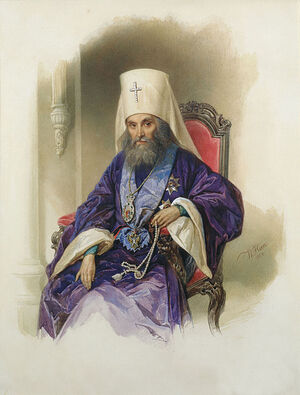 St. Philaret of Moscow St. Philaret ordered that everything be found out about this previously unknown icon:
St. Philaret of Moscow St. Philaret ordered that everything be found out about this previously unknown icon:
“What size is it? What is the style of painting? Was it painted skillfully? Is it ancient? Is anything known about its origin? How long has it been hanging over the church doors?”
In April 1841, Vasily Bogoslovsky, head of the local deanery and priest of the Church of the Icon of the Savior “Not-Made-by-Hands”, in the village of Petrovskoye, informed the metropolitan:
“It was painted skillfully and by all indications it is ancient. Neither the clergy nor the parishioners know about the date of its origin; only in the inventory for 1783 is this icon listed as standing behind the left kliros of the pulled down wooden St. Nicholas Church, and in 1823 it is listed as standing in the high place in the side-chapel of St. Sergius. In 1829, after the old wooden church had been demolished, the icon was placed above the entrance doors in the porch of the newly built stone church and has been there ever since...”
“Why, Father Peter, did they write to St. Philaret that nothing was known about the origin of the miraculous icon?” we asked the rector of the Holy Dormition Church.
“Because the Lord reveals everything exactly when it is needed: neither earlier nor later. It was us, our generation, who needed to know the history of this holy icon,” he replied.
Like the miraculous Kosino (Modena) Icon of the Mother of God, the Stromyn Icon came to Russia from abroad. Some Russian pilgrims brought From Cyprus a copy or even the original miraculous icon, found in the year 392 at the grave of St. Lazarus the Four Days Dead, who was visited by the Mother of God Herself. The icon was brought to the Holy Trinity Monastery—to St. Sergius of Radonezh.
The main relic of the Dormition Monastery on the Dubenka
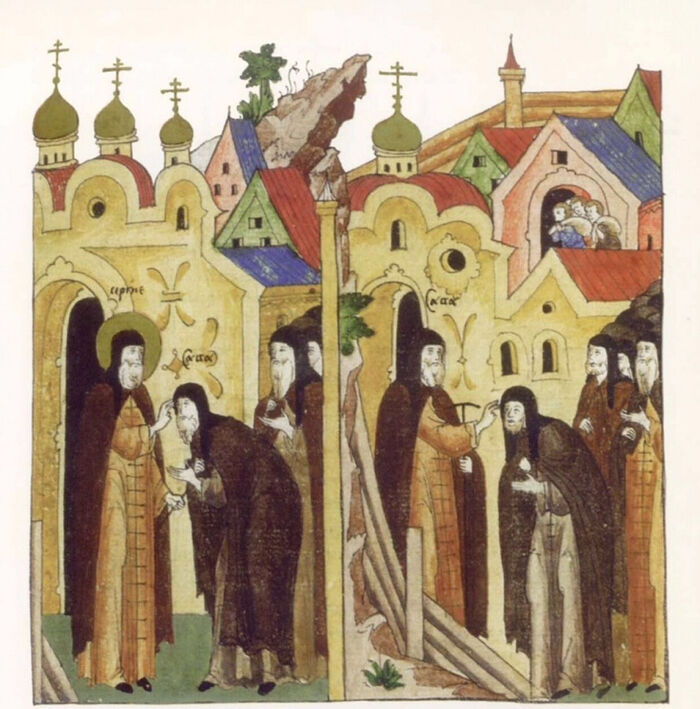 St. Sergius of Radonezh blesses Sts. Savva and Leonty
St. Sergius of Radonezh blesses Sts. Savva and Leonty
In 1379, the “Abbot of the Russian land” handed the ancient relic to his disciples, the Venerable Leonty and Savva, blessing them to build the Dormition Monastery on the Dubyonka River, founded by him in Stromyn.
“St. Sergius gave this great relic to his disciples as his blessing for monastic life in a new place,” Fr. Peter Torik relates. “The grace-filled icon of the Mother of God, according to his plan, sanctified the Stromyn area and became the force around which the monastery was arranged.”
“The same year, 6887 from the creation of the world, by order of Prince Dimitry Ivanovich, the Venerable Abbot Sergius established a monastery on the Dubyonka River in Stromyn and set up the Church of the Dormition of the Most Holy Theotokos in it, and brought an abbot from his Monastery of the Holy Trinity, Leonty by name, and the church was consecrated on the first day of the month of December, and the monks organized everything in the monastery.”3
The monastery of Stromyn was founded even before the Battle of Kulikovo—to commemorate the victory on the Vozha River in 1378 on the eve of the feast of the Dormition of the Mother of God,4 and was consecrated in honor of “Her Holy and Glorious Dormition.” The old Stromynka Street in Moscow, which still exists, was in ancient times part of the road from Moscow through Cherkizovo to the village of Stromyn, on the “sovereign’s pilgrimage route” to the Holy Dormition Monastery.5
“St. Sergius of Radonezh also founded a spring here,” Photina Viktorovna recounts. “The holy well is about a mile away from the church. We call it St. Parasceva’s well, following a Russian tradition, but it was founded by St. Sergius. He (everyone knows this—it was recorded in his Life) did not allow anyone to dedicate holy springs to him, saying: ‘After all, it is not me but the Lord Who has given this holy water to us, unworthy ones.’”
In 1960, the Kurnosovs, a father with children, were driving from the hayfield. They were from the neighboring village of Botovo, and were God-fearing and decent people. Suddenly they saw two venerable elders in white robes next to the holy well. All three saw them. When they turned around, the elders were no longer there. The father is now dead, but his children, Nina and Eugene, still remember it as if it were yesterday: “We were even afraid to look—their robes were snow-white.”
After St. Leonty’s death, Savva, another disciple of St. Sergius of Radonezh, became abbot of the Holy Dormition Monastery.
“Savva of Stromyn, according to tradition, was not only abbot of the monastery here, but also the father-confessor of the Holy Trinity-St. Sergius Lavra,” Fr. Peter continues. “He would walk from Stromyn to the Lavra and back.”
“Google maps” shows that it is about an eleven hour walk each way.
“The Venerable Savva was an amazing man, albeit of uncomely appearance. They say that he was bald and blind in one eye, but was very modest and inconspicuous as a monk.”
“He is often confused with another saint with the same name—Savva of Storozhev,” my brother remarks.
“Great saints! And both were disciples of Sergius of Radonezh.”
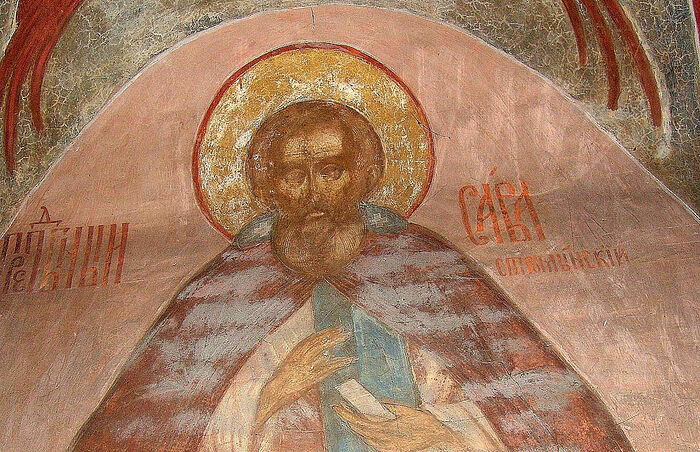 St. Savva of Stromyn (†1392). Fresco of the Holy Trinity—St. Sergius Lavra. Photo: S.A. Zhukov
St. Savva of Stromyn (†1392). Fresco of the Holy Trinity—St. Sergius Lavra. Photo: S.A. Zhukov
A fresco of St. Savva of Stromyn has been preserved at the Dormition Cathedral of the Holy Trinity-St. Sergius Lavra, in the chancel arch leading from the table of oblation to the altar table. The famous Russian historian Count Mikhail Tolstoy wrote in 1860 that “the image of this Savva differs from icons of St. Savva of Storozhev, or Zvenigorod, in that Savva of Stromyn is depicted bent over, with his right eye closed.”6
St. Savva reposed in the Lord in 1392 and was buried here, in Stromyn, in the monastery which he had put on a firm footing.
“In the Moscow province there is the Monastery of the Most Pure Theotokos in honor of Her Holy and Glorious Dormition... To the right of the monastery church there is a wooden chapel over the tomb of our Venerable Father Savva, a disciple of Sergius the wonderworker.”
A half-forgotten relic
The Holy Dormition Monastery stood as the spiritual stronghold of the Stromyn area for almost four centuries. In the late fifteenth century, St. Serapion of Novgorod took monastic vows here, and later became abbot. In the eighteenth century, during the Church reforms of Catherine II, the Holy Dormition Monastery was abolished, as were many other holy Russian monasteries.
But the church remained, as did the ancient cemetery, where the holy relics of St. Savva of Stromyn lay till the time appointed by God; as did the icon of the Mother of God, the miraculous power of which remained hidden by Divine Providence until the very year 1841, when Maura Fayova was healed.
Then there was not enough paper to write down all the instances of healing:
“1. Moscow province, Bogorodsk district, the Resurrection parish, village of Novaya: A peasant Alexei Porfiryev, who could not move his arms and legs for a year and six months, received healing.
2. Vladimir province, Pokrov district, village of Melezha: The peasant Pyotr Nikitin’s daughter, the unmarried girl Anna, whose legs were paralyzed between February 9 and 17 of the same year 1841, received healing.
3. The same province, Alexandrov district, village of Zubtsovo: Peasant Alexei Petrov could not move his arms and legs; according to his testimony, he spent twelve days without food and drink, but when he was brought to church to pray to the Theotokos, he got much better and could walk and use his hands without help; the next day he was healed completely.
4. The same province, Pokrov district, the village of Amelyanovo: Peasant Onisim Tikhonov had been completely paralyzed for twenty years and received healing...”
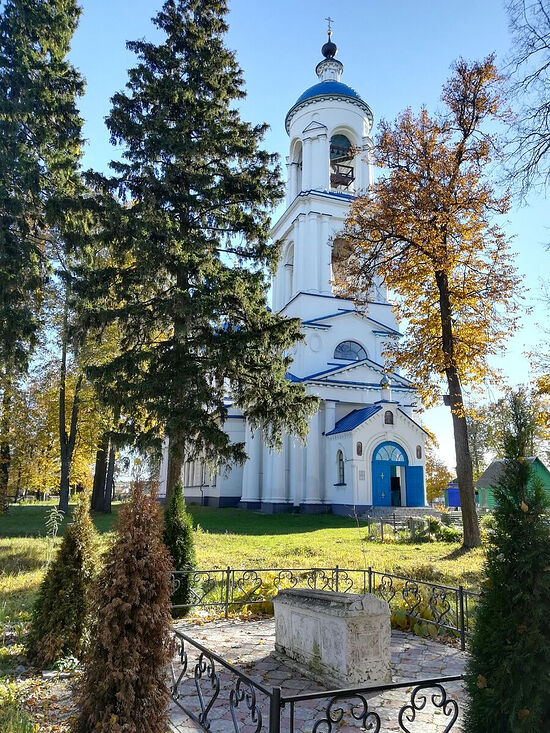 Maura Ioakimovna Fayova’s grave by the Holy Dormition Church in Stromyn
Maura Ioakimovna Fayova’s grave by the Holy Dormition Church in Stromyn
After her miraculous healing Maura Fayova thought about monastic life, but received a revelation from the Mother of God not to receive the tonsure but instead to visit several monasteries and wait for the will of God. So, after spending the next twelve years on pilgrimage, Maura Fayova, having fulfilled her mission, peacefully departed to the Lord at age thirty. She was buried by the Holy Dormition Church, and the epitaph on her tombstone reads: Blessed are the pure in heart: for they shall see God (Mt. 5:8).

